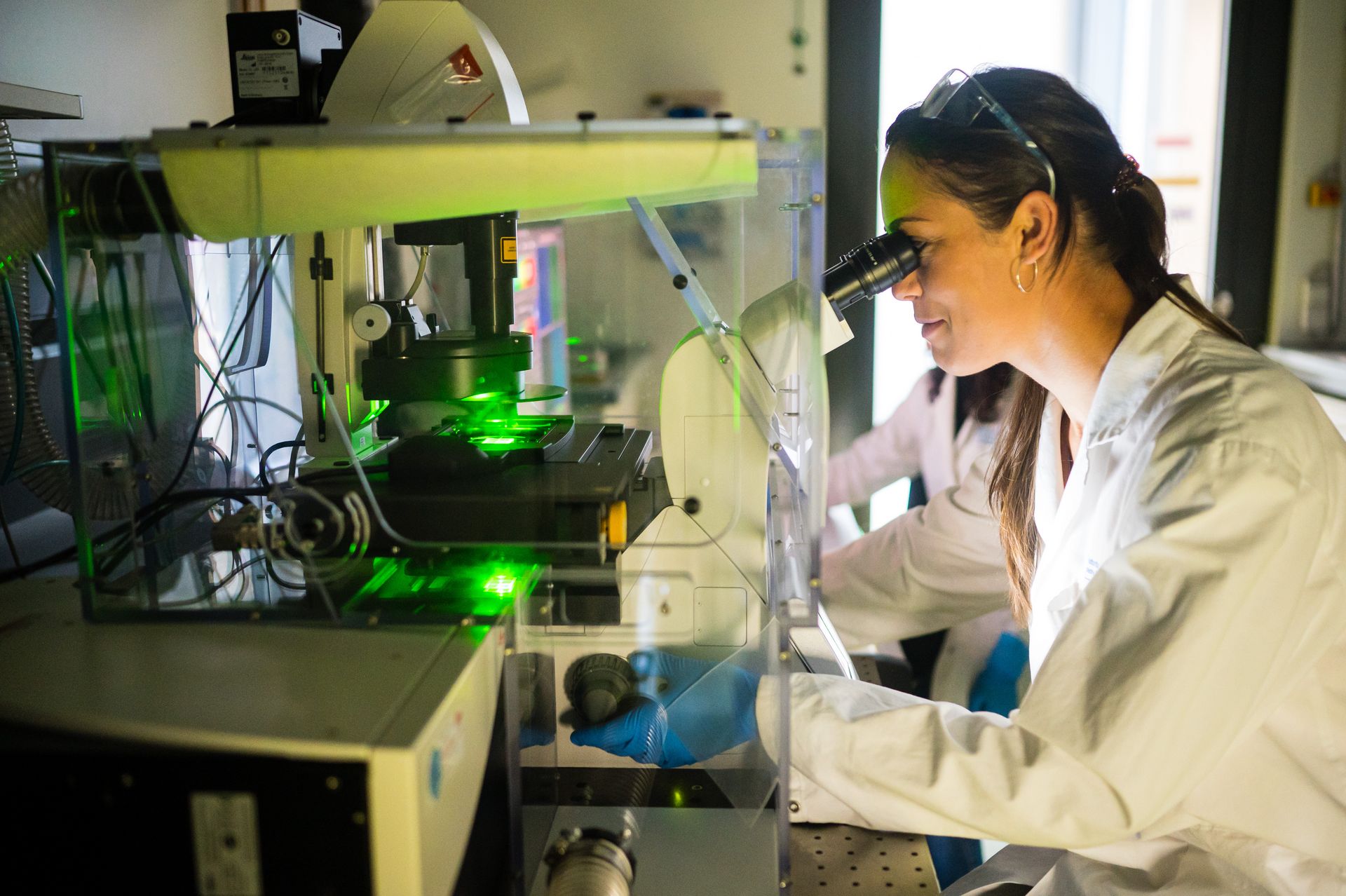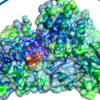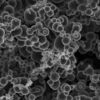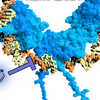
Advancing anti-infective research
Research at HIPS is all about developing novel anti-infectives. We selected our four main research areas to cover most of the pre-clinical drug development pipeline: Microbial Natural Products, Drug Design and Optimization, Biological Barriers and Delivery, and Drug Bioinformatics. This setup instigates collaboration between different departments at HIPS and streamlines the development process.
Research Groups
Our international team closely interacts within the four research areas of HIPS and collaborates with scientists from other institutions, to jointly promote the development of novel anti-infectives.

Natural products from underexplored pathways and extreme environments
Dr Florian Hubrich

Microbial Natural Products
Prof Dr Rolf Müller

Drug Design and Optimisation
Prof Dr Anna K. H. Hirsch

Drug Delivery Across Biological Barriers
Prof Dr Claus-Michael Lehr

Clinical Bioinformatics
Prof Dr Andreas Keller

Anti-Infectives from Microbiota
Prof Dr Christine Beemelmanns

Chemical Biology of Carbohydrates
Prof Dr Alexander Titz

Drug Bioinformatics
Prof Dr Olga Kalinina

Antiviral and Antivirulence Drugs
Dr Martin Empting

Human-Microbe Systems Bioinformatics
Jun Prof Dr Alexey Gurevich

Genome Mining for Secondary Metabolites
Dr Chengzhang Fu

Microbiota-Associated Natural Products
Dr Julian Hegemann

Synthetic biology of natural products
Dr Kenan Bozhüyük

Spatiotemporal single-cell Bioinformatics
Dr Fabian Kern
Microbial Natural Products
During the course of evolution, microorganisms have constantly developed means to gain an advantage over their competitors. Likely, the most notable example is the production of compounds that restrict the growth or viability of other microbes. As these so-called secondary metabolites have continuously evolved to act against certain molecular targets over millions of years, they often show unparalleled biological activity and specificity. Among the most promising producers of bioactive natural products are soil-living bacteria. Although a plethora of potent microbial natural products has already been discovered in these microbes, recent genomic studies suggest that their biosynthetic potential is a long way from being exhausted.
In the research area Microbial Natural Products, we aim to identify and isolate novel chemical scaffolds from soil bacteria and assess their activity against a panel of clinically relevant pathogens. We apply modern genome-mining tools to shed light on the full biosynthetic potential of a large collection of secondary metabolite producing bacteria. Once interesting candidates are identified, we attempt to decipher their molecular mode of action and investigate how resistance to the compound might be mediated. The generated knowledge is then applied to develop biotechnological and chemical strategies on how to improve the pharmaceutical properties of these molecules.
Drug Design and Optimization
To combat the increasing number of resistant pathogens, the discovery and development of new anti-infective drugs with novel modes-of-action is an important goal for pharmaceutical research. At HIPS we synthesize molecules that are designed to bypass antibiotic resistance processes of disease-causing bacteria. These new substances are intended to either act as antibiotics by interference with vital processes or as pathoblockers by switching off their defense mechanisms.
To identify novel anti-infectives we follow different strategies. Some of these are based on computational methods, which facilitate our ligand- and structure-based drug design. Further approaches are based on the screening of compound libraries by biophysical or biochemical methods. Also innovative techniques such as dynamic combinatorial chemistry are useful to identify novel hit compounds. In subsequent steps, we rationally design and synthesize derivatives of these hits to yield compounds with optimized properties, e.g. regarding activity in vitro and in vivo, chemical and metabolic stability and toxicity. The resulting information is highly beneficial to create structure-activity-relationships as a cornerstone for further structural modification and thus MedChem optimization.
Biological Barriers and Drug Delivery
The advances in molecular biotechnology, medicinal chemistry and nanotechnology are opening new avenues in pharmaceutical sciences and novel therapeutics are emerging in the recent years. Nevertheless, it is crucial to optimize new tools and delivery strategies that efficiently overcome the biological barriers such as tissues, cells and clearance mechanisms, reaching the place of action in a dose-controlled manner. One of the challenges to investigate the potential adverse effects of the emerging therapies and understand the mechanisms that govern to cross those barriers is to simulate the complexity of in vivo situation using in vitro approaches. In this regard, sophisticated in vitro models closer to the in vivo structure, function and dynamics are needed.
From the research area of Biological barriers and drug delivery, we aim both to design innovative, non-invasive drug delivery strategies and to develop in vitro models that reproduce the in vivo milieu. We use the cutting-edge technologies in 3D co-cultures, microfluidics and bioprinting to create powerful, reproducible and relevant human-based lung, gastro-intestinal and skin models for investigating the mechanisms governing infectious diseases. Once the key weak spots are identified, we design non-invasive, biocompatible and biodegradable smart drug delivery systems to effectively treat and prevent infectious diseases.
Bioinformatics
Modern biomedical research relies on solid bioinformatics support. Computational approaches play a crucial role in discovering biologically active compounds, describing their biosynthesis, understanding their mode of action, and identifying resistance mechanisms. The staggering rate at which omics data becomes available poses both opportunities and challenges. With an overwhelming number of genome sequences of natural product producers and pathogens, experimental characterization becomes impractical. Although millions of natural product mass spectra hold great potential for future discoveries, their interpretation remains a significant bottleneck.
In our work, we use machine learning, data mining techniques, and algorithmic ideas to approach these problems. Molecular modelling, docking, and molecular dynamics simulations can be used to describe the mechanistic effects of resistance-associated mutations and predict the mechanism of action of novel biologically active compounds. We employ and develop modern genome mining and sequence analysis tools to discover novel promising compounds from natural product-producing bacteria. On a larger scale, individual annotated effects can be combined with machine-learning tools to predict the functional effect of genetic variants without lengthy simulations. Drug targets can be discovered by genome sequencing methods and can be analyzed using data mining to extract motifs accounting for the recognition of specific chemical moieties. The metabolic profiles of drug-producing bacteria can be compared to each other and to existing databases to prioritize candidates for drug discovery.

Microbial Natural Products
Prof Dr Rolf Müller

Microbiota-Associated Natural Products
Dr Julian Hegemann

Genome Mining for Secondary Metabolites
Dr Chengzhang Fu

Anti-Infectives from Microbiota
Prof Dr Christine Beemelmanns

Synthetic biology of natural products
Dr Kenan Bozhüyük

Drug Design and Optimisation
Prof Dr Anna K. H. Hirsch

Chemical Biology of Carbohydrates
Prof Dr Alexander Titz

Antiviral and Antivirulence Drugs
Dr Martin Empting

Drug Delivery Across Biological Barriers
Prof Dr Claus-Michael Lehr

Clinical Bioinformatics
Prof Dr Andreas Keller

Drug Bioinformatics
Prof Dr Olga Kalinina

Microbial Natural Products
Prof Dr Rolf Müller

Spatiotemporal single-cell Bioinformatics
Dr Fabian Kern

Human-Microbe Systems Bioinformatics
Jun Prof Dr Alexey Gurevich

Microbial Natural Products
Prof Dr Rolf Müller

Microbiota-Associated Natural Products
Dr Julian Hegemann

Genome Mining for Secondary Metabolites
Dr Chengzhang Fu

Anti-Infectives from Microbiota
Prof Dr Christine Beemelmanns

Synthetic biology of natural products
Dr Kenan Bozhüyük

Drug Design and Optimisation
Prof Dr Anna K. H. Hirsch

Chemical Biology of Carbohydrates
Prof Dr Alexander Titz

Antiviral and Antivirulence Drugs
Dr Martin Empting

Drug Delivery Across Biological Barriers
Prof Dr Claus-Michael Lehr

Clinical Bioinformatics
Prof Dr Andreas Keller

Drug Bioinformatics
Prof Dr Olga Kalinina

Microbial Natural Products
Prof Dr Rolf Müller

Spatiotemporal single-cell Bioinformatics
Dr Fabian Kern

Human-Microbe Systems Bioinformatics
Jun Prof Dr Alexey Gurevich
Microbial Natural Products
During the course of evolution, microorganisms have constantly developed means to gain an advantage over their competitors. Likely, the most notable example is the production of compounds that restrict the growth or viability of other microbes. As these so-called secondary metabolites have continuously evolved to act against certain molecular targets over millions of years, they often show unparalleled biological activity and specificity. Among the most promising producers of bioactive natural products are soil-living bacteria. Although a plethora of potent microbial natural products has already been discovered in these microbes, recent genomic studies suggest that their biosynthetic potential is a long way from being exhausted.
In the research area Microbial Natural Products, we aim to identify and isolate novel chemical scaffolds from soil bacteria and assess their activity against a panel of clinically relevant pathogens. We apply modern genome-mining tools to shed light on the full biosynthetic potential of a large collection of secondary metabolite producing bacteria. Once interesting candidates are identified, we attempt to decipher their molecular mode of action and investigate how resistance to the compound might be mediated. The generated knowledge is then applied to develop biotechnological and chemical strategies on how to improve the pharmaceutical properties of these molecules.
Drug Design and Optimization
To combat the increasing number of resistant pathogens, the discovery and development of new anti-infective drugs with novel modes-of-action is an important goal for pharmaceutical research. At HIPS we synthesize molecules that are designed to bypass antibiotic resistance processes of disease-causing bacteria. These new substances are intended to either act as antibiotics by interference with vital processes or as pathoblockers by switching off their defense mechanisms.
To identify novel anti-infectives we follow different strategies. Some of these are based on computational methods, which facilitate our ligand- and structure-based drug design. Further approaches are based on the screening of compound libraries by biophysical or biochemical methods. Also innovative techniques such as dynamic combinatorial chemistry are useful to identify novel hit compounds. In subsequent steps, we rationally design and synthesize derivatives of these hits to yield compounds with optimized properties, e.g. regarding activity in vitro and in vivo, chemical and metabolic stability and toxicity. The resulting information is highly beneficial to create structure-activity-relationships as a cornerstone for further structural modification and thus MedChem optimization.
Biological Barriers and Drug Delivery
The advances in molecular biotechnology, medicinal chemistry and nanotechnology are opening new avenues in pharmaceutical sciences and novel therapeutics are emerging in the recent years. Nevertheless, it is crucial to optimize new tools and delivery strategies that efficiently overcome the biological barriers such as tissues, cells and clearance mechanisms, reaching the place of action in a dose-controlled manner. One of the challenges to investigate the potential adverse effects of the emerging therapies and understand the mechanisms that govern to cross those barriers is to simulate the complexity of in vivo situation using in vitro approaches. In this regard, sophisticated in vitro models closer to the in vivo structure, function and dynamics are needed.
From the research area of Biological barriers and drug delivery, we aim both to design innovative, non-invasive drug delivery strategies and to develop in vitro models that reproduce the in vivo milieu. We use the cutting-edge technologies in 3D co-cultures, microfluidics and bioprinting to create powerful, reproducible and relevant human-based lung, gastro-intestinal and skin models for investigating the mechanisms governing infectious diseases. Once the key weak spots are identified, we design non-invasive, biocompatible and biodegradable smart drug delivery systems to effectively treat and prevent infectious diseases.
Bioinformatics
Modern biomedical research relies on solid bioinformatics support. Computational approaches play a crucial role in discovering biologically active compounds, describing their biosynthesis, understanding their mode of action, and identifying resistance mechanisms. The staggering rate at which omics data becomes available poses both opportunities and challenges. With an overwhelming number of genome sequences of natural product producers and pathogens, experimental characterization becomes impractical. Although millions of natural product mass spectra hold great potential for future discoveries, their interpretation remains a significant bottleneck.
In our work, we use machine learning, data mining techniques, and algorithmic ideas to approach these problems. Molecular modelling, docking, and molecular dynamics simulations can be used to describe the mechanistic effects of resistance-associated mutations and predict the mechanism of action of novel biologically active compounds. We employ and develop modern genome mining and sequence analysis tools to discover novel promising compounds from natural product-producing bacteria. On a larger scale, individual annotated effects can be combined with machine-learning tools to predict the functional effect of genetic variants without lengthy simulations. Drug targets can be discovered by genome sequencing methods and can be analyzed using data mining to extract motifs accounting for the recognition of specific chemical moieties. The metabolic profiles of drug-producing bacteria can be compared to each other and to existing databases to prioritize candidates for drug discovery.
Publication Highlights
Have a look at our latest discoveries.




